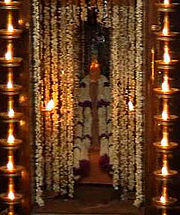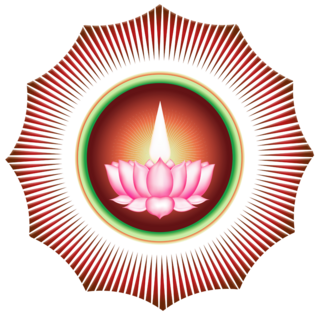
Lord Ayya Vaikundar, known to his followers as tenth avatar or incarnation of Lord Vishnu, also called as Sriman Narayana Vaikundasamy or Narayana Pandaram, was a 19th-century social reformer and iconoclast who worked for the upliftment of downtrodden people in the Kingdom of Travancore. He is central to the Hindu denomination of Ayyavazhi, as per holy scripture.

Ayyavazhi is a henotheistic belief that originated in South India. It is cited as an independent monistic religion by several newspapers, government reports, journals, and academic researchers. In Indian censuses, however, the majority of its followers declare themselves as Hindus. Thus, Ayyavazhi is also considered a Hindu denomination. Officially (legally), it exists within Hinduism as a Hindu denomination.

Kroni is a figure in Ayyavazhi mythology. He is the primordial manifestation of evil, and manifests in various forms of evil, such as Ravana and Duryodhana, in different ages or yugas. In order to counteract and destroy the evil of Kroni's manifestations, Mayon incarnates as Avatars such as Rama and Krishna. He seems to be more evil than the demon Kali of the Mahabharata and Kalki Purana sharing similarities with Lucifer.

Ayyavazhi mythology is the mythology of the South Indian religious faith known as Ayyavazhi, which is officially considered a Hindu sect. The main source of Ayyavazhi mythology is the Ayyavazhi scripture, Akilathirattu Ammanai, and its supplement, Arul Nool. The Akilathirattu Ammanai is a recitation by Mayon to his consort Lakshmi. It is divided into three sections: Early Avatars, incarnational events and post-incarnational events.

Dharma Yukam is the state of absolute bliss as per Ayyavazhi mythology. Dharma Yukam is described in the Akilam seventeen in Akilathirattu Ammanai. It is related to Dharmic moksha and to Abrahamic heaven.

Thuvayal Thavasu, literally washing penance, was a significant religious event that took place in the 19th century. It was also called as thuvayal panthi.. By the late thirties of the nineteenth century, when the religion of Ayyavazhi had come to exist with certain excitement and euphoria, a group of people, of different age groups and genders, undertook to perform this unique exercise as directed by Lord Vaikundar.

The Santror are the seven boys who were brought to life by using the seven seeds from seven upper worlds, by Thirumal, to the Seven Virgins through their instrumentality, according to Ayyavazhi mythology. It also represents their descendants. According to Akilathirattu Ammanai, it additionally represents one who lives with Dignity.

Ekam is the Sanskrit for "one, single, solitary", as a noun meaning "unity". In Hinduism, it refers to a concept of monism akin to that of Brahman in Advaita philosophy and Smarta theology.

According to the Ayyavazhi religion, the Ayyavazhi Trinity is the incarnation of God in the current stage of world development. Ayya Vaikundar, the Incarnation, is the combination of the Ultimate God, Narayana, and Human Being. In Akilam immediately after the Incarnation of Vaikundar, he was viewed simultaneously as the Ultimate God, Narayana, and as son of Narayana. As per the earlier deed Narayana had to destroy Kaliyan, but due to the boons that kaliyan claimed Narayana cannot destroy him. And as per the promise made by Kaliyan, he would only be destroyed, if he give torture to any Pantaram. To overcome all these, such a unique way of Incarnation was planned.

The Akilam one is the first among the seventeen parts of Akilattirattu Ammanai, the religious book of Ayyavazhi. This section includes the Kappu, the very first part; it tells of the Detchanam, and describes the political and sociological situation in the early world.
Akilam four is the fourth section of Akilattirattu Ammanai, the primary scripture of Ayyavazhi. This section narrates the prosperous life of Santror after their marriage with the daughters of King Nirupathi. It also describes the birth of Kaliyan, his cruel activities and its impact in the world.

Akilam Five is the fifth section of Akilam, which is the primary scripture of Ayyavazhi. It narrates the cruel reign of Kaliyan, the death of two Santror and the subsequent curse given to Kali. It also hints about the start of the Kalineesan dynasty that tortured Vaikundar.

Lord Vaikundar was the incarnation of Ekam according to Akilathirattu Ammanai, the religious text of Ayyavazhi and the source of Ayyavazhi mythology. As the Ekam is the supreme power in Ayyavazhi, Vaikundar was the supreme power incarnate.

The Ayyavazhi symbolism deals with the symbols which are used in or used to represent Ayyavazhi. Though Akilam the scripture of Ayyavazhi does not point out any symbol directly, there are a few symbols which are used for representing Ayyavazhi which came into practice gradually.

Akilam six is the sixth section of Akilam, the primary holy text of Ayyavazhi. This section describes the transformation of the ruling authority of the universe from Sivan to Thirumal.

The purpose of this chronology is to give a detailed account of Ayyavazhi from the beginning of the incarnational events of Vaikundar to the present time. Question marks on dates indicate approximate dates. A star (*) indicates the mentioning of that particular date in Akilam or Arul Nool. All dates but a few are found in the Tamil calendar and so doesn't coincide exactly with the months of the Gregorian calendar. The dates may span over any halves of the two consecutive months (Gregorian).

The Akilathirattu Ammanai the scripture of Ayyavazhi teaches Dharma on two different perspective. One in sociology as charity and truth and another under spirituality to attain the stage of Oneness, unified into Lord Vaikundar. This state of ultimate oneness is called as Dharma Yukam or Dharma Pathi. Akilam also says that, Dharma is the only living wheel. The sociological way is asked to be followed by every one to attain the spiritual state of Dharma.

The ethics of Ayyavazhi are found scattered throughout the primary scripture, Akilathirattu Ammanai. They are also integrated with the meta-narrative mythography. However, regarding ethics, Arul Nool is considered as an accumulation and prophecy of the core concepts found in Akilathirattu. In Akilathirattu, the ethical abstracts are pointed out as "told by God" at several places at different situations to lesser god-heads, devas, saints etc. when asked by them.

Ayyavazhi phenomenology is the phenomenological variations found in Ayyavazhi society, worship centers etc. from their holy text Akilattirattu Ammanai.

The religious studies of Ayyavazhi are based primarily on the Ayyavazhi scriptures. Though there is enough knowledge there for a common worshiper to understand Ayyavazhi theology, it needs the Hindu and at some times the scriptures of other religions to be referred to undergo a detailed religious study on Akilam. Because Akilam maintains a unique type of relation with the other scriptures.


